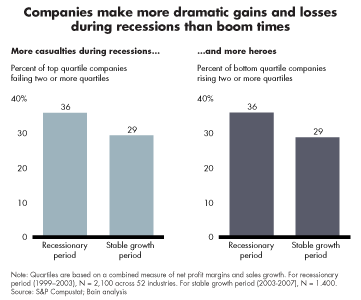贝恩观点 2008年9月30日
作者:Darrell Rigby, Steve Ellis, Sam Rovit, Allen Schaar
在金融市场急剧动荡之际,本期的Results Brief包括贝恩的两个见解: 一个是关于经济动荡期管理所面临的挑战和机遇,另一个是关于即将到来的大公司大规模破产现象及怎样将影响降到最低。
Editor's note: In light of the extraordinary events in financial markets, this issue of Results Brief contains two relevant insights from Bain--one on the challenges and opportunities of managing through turbulence, and the other detailing the looming wave of big-company bankruptcies and how to minimize their impact.
Capitalizing on Curves
by Darrell Rigby and Steve Ellis
The tumultuous events of the past few weeks have battered financial markets and created uncertainty that companies will be reckoning with for months to come. But in the turbulence lies opportunity.
Like dangerous curves on a racetrack, economic downturns create more opportunities for companies to move from the middle of the pack into leadership positions than any other time in business.
Unlike straight-aways, where leaders can thrive on raw power alone, steep curves require strategic finesse. That often results in dramatic differences in performance as leaders steer out of the curve.
 "The right approach: slow in, fast out--like a good driver heading into a sharp curve. The farther you can see and the quicker you can turn, the faster you can safely corner."
"The right approach: slow in, fast out--like a good driver heading into a sharp curve. The farther you can see and the quicker you can turn, the faster you can safely corner."
- Darrell Rigby and Steve Ellis
Consider how Southwest Airlines surged ahead during the 2001 recession. With a clean balance sheet, a clear cost advantage and adroitly hedged fuel costs, the discount carrier grew at the expense of rivals. As others eliminated capacity and jobs, Southwest lowered fares to gain market share. It boosted advertising to trumpet its price advantage and built solid relations with labor by avoiding layoffs.
Southwest is not unique. About 24 percent more firms moved from the back of the pack to the front in the 2001 downturn compared with the subsequent period of economic calm, according to an eight-year study by Bain & Company that analyzed the net profit margins and sales growth of more than 2,500 companies. Meanwhile, about one-fifth of all leadership companies-those in the top quartile of financial performance in their industry-fell to the bottom quartile. By comparison, only three-quarters as many companies made such dramatic gains or losses after the recession.
Recessions hit some industries harder than others, so staying alert matters. The variations get amplified in a globalizing, interdependent economy. That adds both opportunity and complexity. The opportunity is to shift focus to economically healthier regions, as Johnson & Johnson, GE and IBM did in the second quarter of 2008, reporting solid performance outside the U.S. The complexity arises from having to make long-term investments in global operations with less certainty than ever about where you will be exposed when the next downturn hits.

Many industry leaders fall from the top during recessions because they assume that a strong market position is an insurance policy against trouble. That approach breeds overconfidence. Executives postpone taking precautions or reach for the same levers they pulled in the past-like hedging their bets by diversifying. When the downturn hits hard they usually over-react. They slash costs and staff indiscriminately, cut capital expenditures, squeeze suppliers, and avoid strategic acquisitions. Then when conditions improve, they must spend heavily to regain momentum.
The better approach: slow in, fast out-like a good driver heading into a sharp curve. Winners in recessions tend to brake quickly heading into a downturn by managing costs carefully and consistently. It's like downshifting to a lower gear to slow momentum and increase responsiveness. They focus on what the company does best, reinforcing the core business and spending to gain share. They aggressively monitor the competition to ensure they have the best possible line through the curve. That sets them up to accelerate at the apex of the curve, when the economy starts to improve. The farther you can see and the quicker you can turn, the faster you can safely corner.
In the 2001 recession, Intel Corp. timed its acceleration effectively to pull away from Advanced Micro Devices Inc., its scrappy rival in the chip business. Heading into the recession, AMD's heavy investment in product design was paying off, with AMD's revenues growing three times faster than Intel's.
Then the recession hit, catching the entire industry with too much capacity. As AMD's lack of profitability prevented it from investing in new production facilities, Intel seized the advantage. It invested in new facilities with state-of-the-art production capability and spent heavily to advertise its P4 processors. In the ensuing years, Intel's relative cost position improved dramatically and AMD had to slash 15 percent of its workforce. The momentum AMD had built quickly evaporated and a re-energized Intel remained the industry leader.
Another characteristic of companies adept in a downturn: they make bargain acquisitions to build up their core, even when it means taking calculated financial risks. As markets improve, they are well-positioned to accelerate. The latest example: Bank of America's planned acquisition of Merrill Lynch, which may turn out to be "the strategic opportunity of a lifetime," in the words of Ken Lewis, Bank of America's CEO.
For most industries, the optimal time to hit the brakes and downshift was months ago. The questions to be asking now are: Where is the apex of the curve, and how hard should we accelerate to take advantage of competitor mistakes?
Who is in trouble and dumping valuable assets in order to survive? Can we add great people who are now available?
The companies with the right answers to those questions will have the inside track coming out of this downturn.
Darrell Rigby is a partner with Bain & Company in Boston and head of Bain's Global Retail practice. Steve Ellis is Bain's worldwide managing director.
This article first appeared on WSJ.com under the title "In chaos lies opportunity."
Cashed out: the looming bankruptcy wave
by Sam Rovit and Allen Schaar
Wall Street's turmoil suggests two unmistakable lessons. First, even large, global companies need adequate capital reserves to meet unforeseen contingencies. Second, management teams in denial fail to make adjustments to valuations and to operations that are bold enough to prevent a liquidity crisis.
These hard lessons come too late for several storied financial institutions. But the woes afflicting the financial services industry should serve as a warning to other sectors that the economy faces an imminent tidal wave of corporate bankruptcies.

"The woes afflicting the financial services industry should serve as a warning to other sectors that the economy faces an imminent tidal wave of corporate bankruptcies."
- Sam Rovit
The threat might seem unlikely to some. After all, over the past 17 years, total bankruptcies have declined about 5 percent per year, compounded annually. But based on our analysis, speculative grade debt defaults for the largest businesses will increase in the US by five to 10 times over the next 24 months.
Typically, two-thirds to three-quarters of all defaults end in bankruptcies within three months. That translates into 50 to 75 bankruptcies of large companies (assets greater than $100 million) in 2008-and 85 to 105 in 2009. If the economy worsens in the last quarter of this year, bankruptcies will rise even higher in 2009 and 2010.
In one sense, the coming big-company bankruptcy wave was entirely predictable, though its severity was not. Swings in bankruptcy filings move upward along the same trend lines as declines in gross domestic product, and trail economic downturns by 12 to 18 months.

What makes the impending numbers so big was the run-up in large, highly leveraged buyouts in the recent past. Combined with today's extremely limited refinancing possibilities and the slowdown in corporate earnings growth, it creates the prospect of a long, painful road back to stability for many companies, and bankruptcy for others.
The underlying problem is evaporating internal liquidity. Many companies learned to play it close to the edge in maintaining adequate cash reserves, due to widely available speculative debt in the form of junk bonds and leveraged loans. Financial institutions have been wrestling with the unique problems associated with sub-prime mortgages and arcane instruments that are hard to value, as well as a loss of trust. Retail, manufacturing and other service businesses are dealing with liquidity squeezes caused by high debt that was deemed manageable when markets were growing and margins were stable-conditions that do not pertain today.
Some business-hungry lenders exhibited the same suspension of judgment. "Covenant-lite" loans, which lack the normal financial circuit breakers to ensure that lenders get repaid, rose from almost nothing in 2005 to about $97 billion in 2007, or nearly 20 percent of the total amount of leveraged loans issued. That has removed an important early-warning system for financial markets, as well as for banks and companies themselves.
Not surprisingly, the companies most likely to fall by the wayside are those that failed to take aggressive and early actions focused on strengthening their balance sheet and improving cash flow. Those in most danger typically focus on accounting profits instead of cash, pay insufficient attention to tightening working capital, and show a reluctance to sell off assets and pay down debt or close flagging operations. They usually fail to recognize that in tough times it is more important than ever to over-deliver on the few things that customers really value.
Ironically, the behavior of both corporate borrowers and lenders followed what they believed to be manageable risk only a few months ago. The fact is, plentiful credit combined with the pressure to grow meant that many companies borrowed heavily and effectively postponed the financial reckoning that they are now forced to confront. Indeed, a large amount of vintage debt is coming due in about four years, with the growth in maturing issuances forecast to jump 43 percent, from $26 billion in 2008 to $76 billion in 2011. Over the same period, the total of leveraged loans and high-yield bonds coming due will rise from $183 billion to $285 billion.
Companies that successfully navigate the difficult waters over the next 24 months thus will face a second challenge when it comes time to refinance, as banks ratchet leverage ratios way down from their peak of 6.2 in 2007.
That places a premium on having a cash-heavy balance sheet-another reason for companies to act quickly to conserve cash. When companies wait until liquidity is almost gone, or a loan covenant is about to be broken, the predictable result is a cascade of creditor reactions that usually hastens bankruptcy.
Sam Rovit is a partner in Bain Corporate Renewal Group, based in Chicago, and until recently was CEO of Swift & Company. Allen Schaar is also a partner in Bain CRG, based in Dallas and is interim CEO of Marietta Corp.
A version of this article first appeared in The Deal. Read the full article.



 微博
微博 微信
微信